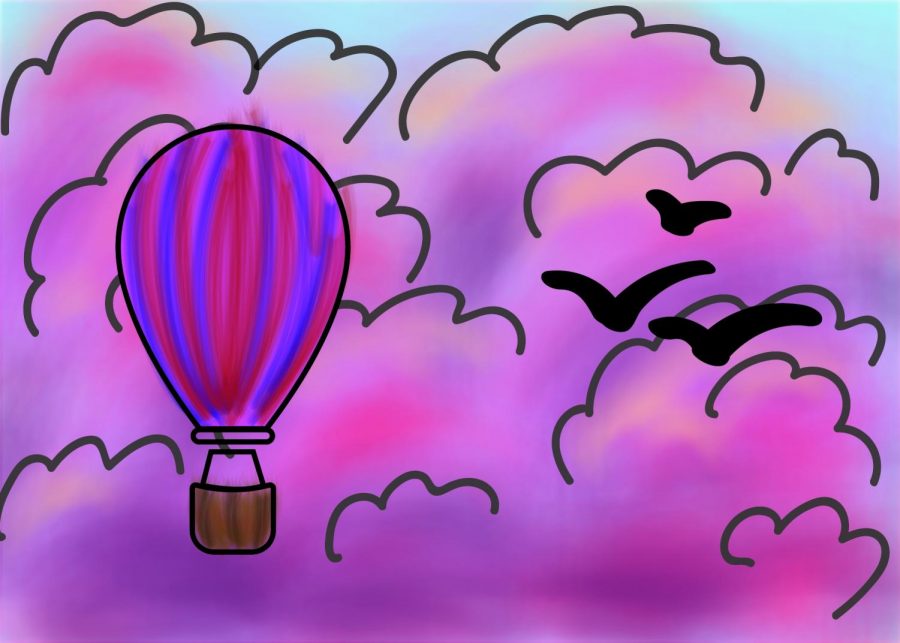The Applications of Lucid Dreaming
April 13, 2021
Most of us have seen Disney+’s “Wandavision” and been awed by Wanda’s mastery of reality. While we may not be able to have her exact power, we can turn to our dreams and go down the path of lucid dreaming. Lucid dreaming is a process in which a dreamer is not only aware that they are in a dream but often possess the ability to distort reality within it – much like Wanda.
Lucid dreaming is a rather common phenomenon, with “55% of adults experienc[ing] at least one lucid dream during their lifetime” according to an article by Dr. Anis Rehman and Danielle Pacheco, with a little less than half of that having lucid dreams a minimum of every month. With it being such a common occurrence, the mystique of lucid dreaming is found in its execution and interpretation, which varies from person to person. For those who have never experienced it, lucid dreaming seems like something out of a fantasy, with Senior Malia Nguyen stating, “Lucid dreaming sounds crazy, I can’t believe people can just control their dreams.” For some who consistently lucid dream, there may be more practical applications, like Sophomore Marcus Heu-Weller experiences. Heu-Weller explains how he uses lucid dreaming to sort through stress, stating, “For me, dreams tend to deal a lot more with stress, so lucid dreaming is a useful tool because I get to figure out what’s going on in my subconscious once I wake up.” Others, like junior Kaiden Thompson modify the approach a little and use it to deal with nightmares. After having constant nightmares as a kid, Thompson learned if something seems a little off, it was probably a dream. “If I saw, say the monster under the bed, I would know to think about it and see what happens. And that’s what I did a lot as a kid to get away from nightmares,” he says. By using lucid dreaming to battle his nightmares, Thompson was actually employing a technique called lucid dream therapy.
Lucid dream therapy does not just deal with nightmares; it may assist with disorders such as Post Traumatic Stress Disorder (PTSD) or depression. Of course, lucid dream therapy is not perfect, and there have been “case studies in which lucidity was achieved, but without control, and it actually worsened the nightmare,” according to research published by Tainá Carla Freitas de Macêdo, and several other psychology professors. Combined with the vivid awareness of lucid dreaming, the inability to control the narrative of the nightmare makes them even more frightening. According to Freitas de Macêdo, these types of lucid dream nightmares are most often seen in patients who have constant nightmares, as well as those with a higher rate of lucid dream occurrence, meaning that lucid dream therapy should be monitored carefully.
Another aspect of lucid dreaming is the enhanced creativity it promotes. According to an article by Patrick McNamara, when narcoleptics (people who are prone to narcolepsy) and a control group were tested for creativity, the narcoleptic group obtained “significantly higher scores,” with “lucid dreaming, in particular, [being] strongly associated with measure of creativity.” However, this is not just supported by studies; Thompson attributes his creative passions today to his ability to lucid dream. “The creativity is great. I feel like it really helped me become interested in music and writing and things like that,” he states. Scientists are not yet sure about the exact scientific process that contributes to increased creativity, but Thompson explains that he felt lucid dreaming enhanced his creativity since his thoughts became reality, and it just became a matter of thinking about something unusual happening to make it happen. This in turn became him pushing the limits of lucid dreaming to make certain things happen. “Sometimes I would just make it rain chocolate milk or try and see if I could make a bus fly up to a mountain,” he illustrates. In contrast, Freshman Anusha Manoj uses her dream manipulation to create an orderly scene. “I like the control it gives, and I don’t like random colors flashing in my brain,” she elaborates, stating, “If I am in a restaurant, but I feel like going home, I can just switch it to my house… The control opens up possibilities.”
New studies on lucid dreaming focus on the exploitation of small movements that dreamers can make through their slumber. Lucid dreaming occurs in REM sleep, in which every muscle except your eyes is paralyzed. This occurs due to REM atonia, where a person’s muscles are frozen throughout sleep, so they do not act out their dreams. However, the eyes are able to still twitch about, and researchers are using this ability to test consciousness during lucid dreaming. A recent study published in Current Biology does just this; researchers asked yes or no questions to subjects while they underwent lucid dreaming. Beforehand, they had established that looking separate directions would convey different answers, and had created a code. Eighteen percent of the time, correct answers were given, with 3 percent giving incorrect answers. Sixty-four percent of participants did not respond and with the remaining 18 percent responses were unclear. While there may not have been an overwhelming majority to correctly respond, this study marks exploration in lucid dreaming and opens up many new possibilities to scientific application.
While there is a lot known about lucid dreaming, many details about it remain shrouded. Many advancements with it have been fairly recent, with lucid dreaming first proven in 1975. Since then, there has been constant application of lucid dreaming to psychological well-being, as well as more recent discoveries into two-way communication through dreams. The ability to be aware and able to have small movements during lucid dreaming set it apart and provide endless possibilities on its usage.


